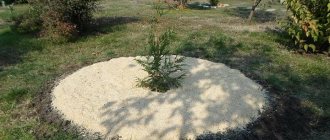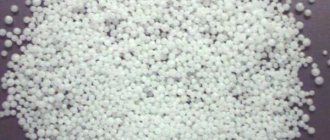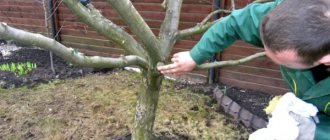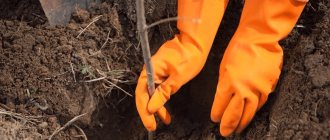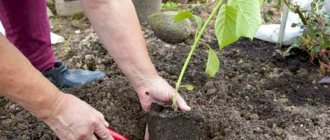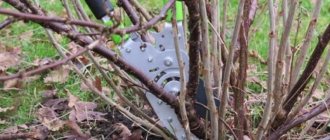As soon as the sun begins to warm up in the spring, the snow begins to quickly melt. And this is the time when it’s worth visiting your summer cottage and inspecting the condition of perennial flower crops. First of all, you need to pay attention to plants that have overwintered under cover in order to understand when they need to be removed. So, if the covers are removed early, the plants may freeze during spring return frosts. If removed later, the buds on the bushes may damp out and die from excess moisture. And first of all, let's pay attention to the roses.
Roses are beautiful, rather capricious plants. In order for them to delight with their lush flowering in the summer, in the spring it is necessary to properly bring them back to life after a long and sometimes harsh winter. And you need to start caring for them before the plant begins to grow. Therefore, starting from mid-spring, you must first of all start uncovering overwintered plants, pruning them, transplanting last year’s bushes to a new place and planting newly acquired seedlings. This is what will be discussed later in the article.
Pruning roses in spring for beginners + step-by-step pictures
After the shelter has been completely removed, they begin to trim the shoots to healthy tissue. Pruning is necessary to remove old branches growing inside the bush, preventing access to the sun and for better ventilation. First, use pruning shears to cut the stems from the center of the bush to defuse it. If buds form on regrown shoots from last year, shorten them sufficiently, this will only stimulate flowering. It's done like this.
- On young bushes we leave 2-4 buds, approximately 15 cm from ground level.
- In adult shoots, 5-6 buds are left at a distance of 20-25 cm from the ground.
- On two-year-old shoots, 2-3 lateral branches are left and each of them is shortened, leaving 2-3 buds.
When pruning roses in spring, follow the rules.
- The cut is made with a sharp knife at an angle of 45º above the kidney, which faces outward;
- To obtain smooth cuts, remove all irregularities, which is an important condition for preventing the colonization of cuts by pests and microbes;
- All diseased, dry and thin shoots are removed,
How to properly remove cover from roses?
Every gardener, as they say, dances depending on the weather. It is the weather conditions that will tell you when to open the roses. But before you completely remove the cover from the plants, you will have to carry out a number of procedures.
It is worth considering that the flowers will begin to come to life as soon as it gets slightly warmer outside. This usually happens already in early or mid-March. The process of bud formation begins, while the root system may still be dormant if the soil remains frozen and cold. During this period, the shelter cannot be removed; on the contrary, care must be taken to additionally protect areas exposed to snow. Usually the top of the shelter remains bare, and the snow may also melt from the ends. If this happens, you need to throw snow on these open areas yourself.
After a few days or even weeks, usually in the middle - end of March, sharp changes in temperature are no longer observed, so you can remove all the snow from the shelters and make grooves to drain melt water, otherwise it can damage the root system of the bushes. During the same period, you need to ventilate the roses. To do this, you need to slightly raise the shelter on opposite sides, secure it at a height of about 20 centimeters and leave for 30 minutes.
After a week you can ventilate again. And if the roses are climbing, standard or miniature, it is also necessary to loosen the soil, sawdust and leaves with which the flowers were spudded. After this, we cover the bushes again, but leave small gaps for ventilation.
How to feed roses in spring for lush flowering in the garden
The first fertilizing is carried out when the earth warms up and there are no longer night frosts. Then the root system begins to work and the leaves begin to bloom. It is better to carry out joint fertilizing with organic and mineral fertilizers. Of course, organic matter is healthier; it not only nourishes the plant, but also improves the structure of the soil.
But the application of increased doses of mineral fertilizers in the soil creates an excessive concentration of salts. They oppress plants and lead to the death of the root system. This is where organic fertilizers come to the rescue, absorbing some of these compounds and releasing them to the plant. How can you feed roses?
Nitroamophoska is a complex mineral fertilizer. Contains
- nitrogen, which is needed for active growth,
- phosphorus - helps abundant flowering,
- potassium - promotes ripening of wood.
Nitroamophoska is diluted in hot water - 1 tbsp. l. for 0.5 liters of water. Then the solution is poured into a 10-liter watering can and the plant is watered at the root.
Organic fertilizers - try using an infusion of chicken manure. Manure granules are poured into a bucket 2/3 full, filled with warm water, and left for 5-7 days. After that, 0.5 liters of infusion are diluted in 10 liters of water and the plants are fed.
How to properly feed roses?
Before fertilizing your rose bush, make a small depression around it. In dry, sunny weather, be sure to water the soil well before fertilizing.
Afterwards, first fertilize with mineral fertilizers; gradually pour 5 liters of solution into the hole per bush. As soon as the mineral fertilizer is absorbed, then water it with infusion of bird droppings. We also pour 5 liters of solution into the depression near the bush. Then the hole where the fertilizer was applied is filled with humus. It will provide additional nutrition and mulch.
Such feeding is carried out every year. The next feeding is carried out in the summer, during the budding period before flowering.
Burn of rose branches - fungal disease
The death of plants during the wintering period occurs not so much from low temperatures, but from excess humidity under the shelter, and this often leads to damping off of the plants and contributes to the development of a dangerous fungal disease of the branches - burn.
Small single red spots first appear on the branches of roses, sometimes collected in colonies. Gradually the spots grow and merge into one red-brown spot. The middle of the spots turns yellow, red, or gray, but the reddish border remains.
If the spots ring the branches, and tissue deposits form on the branches above the affected area, then such branches die off within 2-3 months, and the entire bush can die in 3-4 years.
By the end of the growing season, numerous tubercles (pycnidia) form in the form of points on the surface of the spots, inside which spores mature (the causative agent of the burn is a fungus). At this time, the bark in the middle of the spots cracks, and through the gaps damage to the bast tissue and wood is visible. The fungus overwinters in the affected branches.
What to do if roses turn black after winter?
Roses have been under cover for a long time during the winter; they have “lost the habit” of the sun’s bright ultraviolet radiation, so when sunny days arrive, do not rush to open the bushes. Some gardeners, delighted by the sunny fine days, immediately remove the shelter. But when they come to the plot the next day, they see that the roses have turned black. Why did this happen?
And it’s not the cold that’s to blame, but the sun. It bakes the plants, and they get sunburn. This is similar to when a person came to the sea to sunbathe. A person, feeling that his skin is burning, goes into the shade, or completely leaves the beach. But the plants cannot go anywhere; if they remain in the sun, they get burned, sometimes fatally.
If the graft is not buried in the soil when planting, it may burn and then nothing will grow from under the soil. Therefore, keep the roses under cover for another week after the snow has melted. Under spunbond in the sun, the bushes will not steam or burn.
And another situation was when the bushes were covered with film for the winter. As soon as the snow melts, it becomes warm, the film is removed immediately, there is no need to be afraid of frost. Because the flowers are covered with a film, a greenhouse effect is created under it, it soars strongly, and the plant that is propped up is guaranteed to die.
What to do in such a situation? There is only one way out: prepare your roses for winter correctly.
Types of manipulations
Pruning can be either strong, medium or weak. Climbing and park roses lend themselves to light pruning. To do this, cut off the upper part of the shoot, leaving 10 buds, from which short shoots will appear in the future. They will begin to bloom in June. Such shoots cannot be pruned.
Basically, roses undergo medium pruning, when only seven buds remain on the shoots. The young branches will be long, but they will begin to bloom a little later than after light pinching.
If rose bushes are heavily pruned, flowering will begin after a month. Only three buds should be left on the shoots, which will later grow into strong branches.
Note! Climbing roses are not recommended to be heavily pruned as they may not bloom. However, old bushes can be pruned. This way they can be renewed and rejuvenated.
Experienced gardeners advise adhering to the following rules regarding pruning various types of roses:
- For polyanthus, tea and floribunda, both medium and heavy pruning can be used.
- Miniature species (for example, borders, cordana) can only be thinned out and the shoots shortened by half.
- At least six buds should remain on remontant plants after pruning. Due to this, the crop will bloom profusely this season, and next year it will bring excellent growth of shoots.
- Climbing, park and scrub trees are subject to exceptionally light pruning. However, it should be remembered here that in climbing plants that flower repeatedly, it is necessary to pinch only the side branches and in small quantities, and the main shoots should not be touched. It is generally undesirable to prune once-blooming climbing crops in spring.
- The centenary rose bush should not be pruned at all for the first couple of years after planting. After this, in the autumn it is necessary to carry out formative pinching, leaving fifteen strong shoots of different ages and removing weakened and thickened stems, as well as those growing inside the plant. At the end of the flowering period, flowering shoots must be shortened by half.
- Standard varieties of rose bushes only need to be thinned out or lightly pruned.
- Ground cover plant species can only be rejuvenated and sanitary pruned.
In principle, there is nothing complicated about pinching different types of roses. The main thing is to choose the right type of pruning so that the plant can continue to bloom and grow normally.
You may be interested in: Caring for peonies in the open ground in spring
Planting roses in spring - when and how to plant roses
In the south of the country , where the climate is milder, the removal of the shelter is carried out in mid-March, when the cold nights with light frosts stop. Planting and replanting roses is best done in autumn or spring. The seedlings grow quickly, because after 2-3 weeks they take on new roots.
In central Russia, cleaning of shelters is carried out later by 2-3 weeks, sometimes up to a month, approximately from the end of April to the beginning of May. And the best time to transplant is spring and autumn.
In the Moscow region, open-ground seedlings are planted in March. Moreover, seedlings purchased in the fall can be stored in the basement at a temperature of 0° +3°C until spring, in a box with wet sawdust or sand.
In Siberia and the Urals , where the climate is characterized by late autumn, fleeting summer, and winters are more severe and longer, therefore frost-resistant varieties are suitable for cultivation. When purchasing, give preference to grafted varieties, since they tolerate cold more easily and have stable immunity. The shrub also takes root in the soil faster. You can plant roses in open ground in the fall. However, experienced gardeners recommend doing this better in the spring.
For successful wintering, the plant must be strong, well rooted and must enter the dormant stage. Since the calendar autumn and the actual one are often very different, it is not always possible to calculate the timing of planting a rose in the fall so that the plant does not actively begin to grow, devoting all its efforts to forcing new branches. Such plants do not have time to ripen before the onset of low temperatures and automatically fall into the risk group.
Seedlings with closed soil, purchased in containers in the fall, can be planted immediately in the fall in the ground in September, or left in them until planting in the spring.
Transplanting roses in spring - step-by-step instructions
First, we make a planting hole measuring 40x40 m and up to 0.5 m deep. Pour a little superphosphate into the bottom of the hole and mix it with the soil in the hole.
If you have banana peels, throw them into the hole too. The peel is not only the richest source of potassium. But it quickly decomposes, thereby promoting the proliferation of earthworms and beneficial microorganisms. Bury the peel with soil. Before planting, soak the seedlings themselves in Kornevin’s solution, then cut the roots of the seedling, place it in the center of the hole and cover it with earth.
When planting rose seedlings, it is important to take into account that the seedlings are buried so that the grafting is 5-8 cm below the soil level. This way the plants will be protected from frost and, perhaps, over time they will grow on their own roots, which will also increase their frost resistance.
We cover the soil in several stages. For the first time, we filled the hole with earth, trampled it down, and poured water on it. After this the earth has settled, we fill it with earth again and water it.
After planting, we hill the seedling by 10-15 cm, this is what will protect the roots from moisture loss.
Replanting a bush
Rooting rose seedlings in a temporary place in the fall, they are transplanted to a permanent place in early spring. And they replant just at a time when the ground is no longer frozen, but the plant has not yet woken up.
First, we dig up the bush from all sides with a bayonet shovel. We carefully lift the earthen lump with a shovel, trying not to destroy it, and transfer it to the right place, that is, to a pre-prepared hole. Please note: the earthen ball should be as large as possible so as not to disturb the root system of the plant. And then we proceed as with any landing.
The seedling itself, or rather its bud, is buried 3-5 cm when planted. The deepening protects the graft from freezing in cold weather and from drying out in hot weather. It also suppresses rose hips. And at the end of planting, we cover the seedling with covering material, so it is protected from the scorching sun during the day, and from lower temperatures at night.
Necessary pruning
Caring for rose bushes after winter also involves pruning the plant. To perform this procedure, you need to prepare a garden pitcher, a saw and sharp pruning shears.
A few tips to keep in mind when pruning shrubs:
- Spring pruning should be done every year.
- The procedure is carried out before the buds open.
- If all branches are removed, stumps should never be left behind. They will have to be cut down to the very base.
- The cut should be at an angle of 45 degrees, 5 millimeters above the healthy kidney, which is located outside.
- To form a bush, you need to leave only 5 branches, and cut the rest to the very base.
- Disinfection of the pruning shears is carried out after processing each flower.
There are two types of pruning of rose flowers - formative and sanitary.
The very first thing to do is sanitary pruning, which involves removing deformed and old branches, as well as those growing inside the bush. All cut areas must be treated with garden varnish or brilliant green to prevent infection.
Particular attention should be paid to grafted crops. All wild shoots that grow below the grafting site must be completely cut off. After this, the flowers are spudded, and the soil with the shoots is treated with copper oxychloride.
Why is it necessary to carry out formative pruning in order to:
- form a bush;
- stimulate active growth.
Formative pruning will differ in terms of completion time for each type of rose bush. Early flowering varieties should begin pruning in April, before the buds open. Climbing, ground cover and hybrid tea roses can be pruned already in May, after blooming.
Watering roses in extreme heat in summer
Roses are very picky about the condition of the soil and its moisture. If the soil is fertilized and loose enough, drip irrigation can be organized. If this cannot be done, then watering is carried out manually from a watering can about 1-2 times a week, but quite abundantly. 0.5-1 bucket of water is poured under one bush.
But you need to water it correctly. First, you need to dig a shallow ditch around the bush, and gradually pour water into it. First a small amount, wait until the water is absorbed, and then add water again. To prevent water from evaporating longer, mulch the soil under the bush.
Plant nutrition
After pruning, the flower crop must be properly cared for. As soon as the first leaves are formed, the plant begins to actively take nutrients from the soil. In this regard, it will be necessary to fertilize the bush.
How to properly apply fertilizer to open ground where rose bushes are grown:
- First, you will need to thoroughly moisten the soil near the bush with lukewarm water.
- After this, nitrogen-containing fertilizer should be applied around the plant, keeping a distance of fifteen centimeters from the trunk. As a fertilizer, you can use ammonium nitrate or Kemira. In what proportions to add drugs to the soil is indicated directly in the instructions. The specified dose cannot be exceeded. The plant will feel better from a nutritional deficiency than from its excess.
- Then the soil must be loosened and moistened again with warm water.
After seven days, the soil must be fed with organic compounds. To do this, each bush should be fertilized with humus (you will need half a bucket), which needs to be slightly deeper into the substrate. After this, the soil needs to be watered.
If, after adding mineral compounds to the open ground, the rainy season has begun, after a couple of weeks it is necessary to repeat the fertilizing, which will contain nitrogen, since most of the nutrients have been washed out of the soil.
Also, foliar feeding with calcium nitrate will be useful for flower crops. This solution should be sprayed on both the bush and the ground near it. The procedure is carried out in the evening when the weather is warm outside.
Fertilizing is applied to open ground twice a year, namely in spring and summer (carried out before the second flowering phase). If young seedlings are not two years old, then fertilizers are not needed. The nutrient substrate into which the flowers were transplanted will provide the plants with the necessary supply of microelements for active development.
After pinching and feeding, the bushes must be mulched. This procedure is necessary to retain moisture and to create a normal microclimate in the ground.
Clue! Pebbles, humus, peat, hay or rotted sawdust can be used as mulch. In this case, the mulch layer should evenly cover the soil by about six centimeters, without covering the trunk of the plant.
Caring for roses in early spring
Having opened roses in early spring, we sometimes see that the bushes have dried out and do not seem to be alive at all. Don't rush to dig them up and throw them away. It is quite possible to revive them. How to do it?
Experienced gardeners recommend covering such plants with a plastic water bottle with the bottom cut off. Such a bottle is placed on a bush, closing the bottle with a lid. This creates a greenhouse effect inside the bottle. Cover the sides of the bottle with masking tape, or wrap it in newspaper, securing it to the bottle with an elastic band or string. This way the plant will not be hot, even in sunny weather. Increased humidity is created inside the bottle and the buds will wake up faster.
When the leaves appear and the shoots begin to grow, unscrew the cap on the bottle, but do not remove the bottle itself. There is no wind under the bottle and the plant will be comfortable there, it feels more protected and develops well.
Before placing the bottle, you can spray the rose with growth stimulants, for example, Kornevin, Energen, NV-101. This way you can speed up and wake up the kidneys.
Troubleshooting
After opening and hilling, rose bushes must be inspected for the presence of infectious diseases, as well as rotted and frozen flowers. If the branches are frozen, they will become dry and turn brown. Therefore, they will have to be cut off immediately.
Sometimes after winter, a rose bush may look lifeless. However, you should not throw it away, since it is capable of growing from renewal points. For these purposes, you will need to trim the branches, and then monitor the further development of the crop. In May the plant should come to life.
To check whether a garden crop has died after winter or not, it is enough to carry out one simple procedure. You need to move the bush a little. If it wobbles, it means the root system is dead. If it doesn't wobble, the plant is alive.
In rare cases, it happens that the weather is still warm in the fall. Because of this, sap flow begins in the crops, and with the arrival of frost, the plant simply freezes. As a result, both small and large cracks form on the shoots. In early spring, sap flow resumes again, and harmful bacteria penetrate into the flower through cracks.
If damage is noticed, the deformed branches must be removed, and the cracks should be coated with copper sulfate or manganese solution. Then all sore spots need to be treated with garden varnish.
You may be interested in: Cossack juniper: planting and care
Roses may also show mold. The reason is that the plant was not processed in the autumn. To get rid of mold, the bush should be wiped of plaque and then washed with either a soap solution containing copper or iron sulfate.
A crop can only be banned if the protective cover was removed too late. This may be evidenced by the formation of reddish-brown spots on the shoots, which later become dark closer to the center.
The spots may spread throughout the entire stem. For this reason, it is necessary to remove diseased shoots down to healthy tissue and then burn them. The plant will need to be treated with a fungicide that contains copper (for example, copper oxychloride).
If the bush has been completely deformed, it must be uprooted and burned. Shoots with minor damage can be left untouched until summer pruning after flowering.
How to treat roses in spring against pests and diseases
Roses are loved not only by people, but also by numerous pests, such as aphids. Immediately after pruning, plants should be sprayed with insecticides and fungicides. This is the prevention of the development of diseases and the appearance of pests on the bushes. Treatment is carried out with chemicals:
- 1% solution of copper sulfate,
- 3% solution of iron sulfate,
- 1% Bordeaux mixture,
- Karbofos,
- Insecticide,
- Fitoverm.
The drugs are diluted and used according to the instructions for use. Be aware that the listed products are very toxic to young leaves, so treatment is carried out before buds begin to appear. Among folk remedies, nettle infusion and soap solution are used.
Have a good harvest!
Preventative treatment
Caring for the crop should be year-round. Fertilizing shrubs in the summer is as important as covering plants in the fall for the winter. No less important is pruning shoots after winter and treating bushes against diseases and pests in the spring. After the bushes have been opened after winter, roses need preventive maintenance. Seedlings need to be treated to prevent infection with powdery mildew, rust, aphids and spider mites.
To treat infections, use the following solution: Take 100 grams of copper sulfate with a concentration of 3% and add it to a bucket of water. Next, spray the bushes and the soil next to the bush.
Final spring work
Roses in the spring require not only fertilizing, but also mandatory mulching. To do this, use peat, humus or peat manure compost. It will help preserve moisture and optimal soil microclimate, and will also perform not only a protective function, but also enrich the soil and improve its quality. Pebbles are also used for mulching; they can retain moisture and choke out weeds.
At the end of April-May, when foliage appears on the bushes and buds form, a second treatment of roses against pests and diseases is carried out.
Along with popular fungicides, safe traditional methods are often used. For example, spraying with a soap solution (add 200 grams of laundry soap to 10 liters of cold water) or infusion of nettle and tansy.
To prevent fungal diseases, roses are treated with phytosporin in the spring. Also for this purpose, spraying with a solution of wood ash or mullein is carried out.
The universal action drug RoseClear has been developed especially for roses. It is both a fungicide and an insecticide. It fights almost all diseases and pests of roses.
Please note that rose hips, tea species, fruits and petals of which you plan to use for food purposes can only be processed using natural means!
Roses are processed in calm, dry weather, preferably in the evening. When using chemicals, do not forget about personal protective equipment.
Pests, diseases. Fighting methods
Pests and diseases of roses.
Control methods Roses, like other plants, are attacked by pests and affected by diseases. This may cause damage or even death. To prevent this from happening, you need to pay due attention to the problem and promptly treat it, as well as make sure to do preventive measures. Don't forget about your own safety. When carrying out procedures, use protective equipment: rubber gloves, respirators. After the event, wash your face and hands thoroughly with soap.
Prevention
To prevent damage, immediately after the active growth of the rose, it must be sprayed with a fungicide or insecticide, for example, RoseClear. It is better to carry out such preventive actions every 10-15 days, choosing windless, dry evenings.
Pests and methods of controlling them
These small insects are especially dangerous during the development of buds, shoots, leaves and flowers. This is when plants become food for larvae and most in need of protection. Let's look at the most famous pests, as well as methods of combating them.
rose aphid
Rose leaves damaged by rose aphids
Hunt in huge colonies. Settles on the lower part of the leaf, buds. Its larvae are practically invisible. They reproduce very quickly; during one growing season they can produce 2 million larvae. Roseate aphids harm plants by sucking their sap. In this case, the flower is deformed, distorted, weakened. May die in winter.
Fighting methods:
- Karbofos (60 g per 10 liters of water);
- kerosene (2 g per 10 liters of water) - every 10-13 days;
- Spark (10 g per 10 liters of water);
- Fitoverm (2 ml per 1 liter of water).
Spider mite
Spider mite on a rose
Appears in summer in hot and dry weather. The female produces about 180 eggs. Spider mites settle on the lower part of the leaves, sucking the juice from the plant and causing metabolic disorders. The leaves turn yellow and fall off.
Control measures: Agrovertin, Fitoverm (2 ml per 1 liter of water) every 10-20 days, enough for 10 square meters of area. Colloidal sulfur (40 g per 10 liters of water) - one liter is enough for five rose bushes.
Leaf rollers
Rose leaves damaged by leaf roller caterpillar
Appear in early spring. Leaf-roller caterpillars gnaw leaves at the edges and roll them up, gradually exposing the entire bush.
Control methods: Spark (1 tablet per 10 liters of water) – enough for 50 square meters of area. You can also collect insects with your hands.
Click beetles
Click beetles destroy pink leaves.
They are found in areas infested with wheatgrass. Click beetles eat the stems of the rose bush and its roots.
Control methods: Bazudin (15-20 grams per 15 square meters) is laid out on the ground near the bushes.
Olenka and bronze
The fawn and bronze fawn love to eat rose flowers.
They live from May to August. Females lay eggs in the ground, and the beetles appear in the summer. They feed on flowers and pistils of roses.
Methods to combat bronze moths: in the early morning, when they are motionless, they can be collected.
Diseases and methods of combating them
Roses most often begin to get sick from unfavorable conditions, such as lack of moisture, nutrition, light, or excess nitrogen in the soil. Infection can also occur from the leaves of diseased plants that remain on the site. Below are the main, most dangerous diseases and methods of combating them.
Powdery mildew
Starts in mid-summer. It spreads very quickly between bushes. The disease looks like a white coating on the buds and shoots. Subsequently, infected plants become deformed and dry out. Excessive humidity, lack of lime, and oversaturation of the soil with nitrogen contribute to the appearance of powdery mildew.
Control methods: affected parts are cut off and removed. The earth is being dug up. The bushes are treated with copper sulfate (100 grams per 10 liters of water) from the beginning of spring. Having seen signs of powdery mildew, the rose can be sprayed with: Topaz (4 ml per 10 liters of water), Skor (2 milliliters per 10 liters of water), Gray colloidal (40 g per 5 liters of water).
Rust
Rose affected by rust
Spreads by spores. Orange cushions become visible on the foliage and shoots of roses. The most resistant to this disease are climbing, hybrid, and polyanthus varieties; Less resistant are remontant and red-leaved roses.
Methods to combat rust: Hom (40 grams per 10 liters of water) - sprayed on one hundred square meters of area. The soap solution for spraying is prepared as follows: 300 grams of soap are diluted in ten liters of hot water, cooled, and sprayed with a pump. Sick roses are uprooted and burned.
Chlorosis
Rose leaves affected by chlorosis
This is a lack of iron, often manifested in alkaline, neutral and oversaturated soils with calcium. The leaves of infected plants first turn yellow around the edges (especially young ones), and a green stripe remains near the veins. Later they turn white, die and fall off.
Control methods: Kemira Universal 2 (1 tablespoon per 10 liters of water) – apply to the soil 2-3 times. Ferrilene, Ferovit, Iron Chelate, Antichlorosis are also used. Iron chelate can be prepared at home: 20 grams of ascorbic acid and 10 grams of copper sulfate are dissolved in one liter of boiled and cooled water.
Mulching
Mulching is a procedure that greatly helps gardeners provide high-quality care for their garden and roses. Mulch optimizes soil structure, protects the soil from hypothermia and overheating, helps maintain normal moisture levels, prevents the growth of weeds, and protects against leaching of nutrients from the soil.
It is recommended to mulch roses in the spring after applying fertilizers. Compost, sawdust, peat, pine needles, and mowed grass can be used as mulching material for flowers. The thickness of the layer is approximately 5 centimeters. In this case, the material should not touch the barrel.
Advice! Before mulching, it is recommended to spread rotted compost around the bush (one bucket for one bush).
